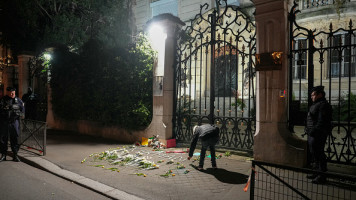US art teacher's dismissal over depictions of Prophet Muhammad sparks condemnation and praise
The sacking of an art history teacher at a US university for showing depictions of the Prophet Muhammad sparked heated debates, with Muslim groups and commentators split over the dismissal.
Hamline University professor Erika Lopez Prater was dismissed after she showed her students a 14th-century painting of the Prophet Muhammad receiving his first Quranic revelation through the Angel Gabriel.
A majority of Muslim scholars consider depictions of prophets forbidden, even if the images are meant to venerate the religious figures.
Prater issued a number of cautionary statements before showing the painting, allowing students to opt-out of the session and raise any concerns beforehand. Despite no issues being raised, after the image was shared on 8 October, Muslim student Aram Wedatalla voiced her discomfort and complained.
This was backed by other Muslim students - some of whom were not in Prater's class. Hamline then decided to end Prater's teaching contract in the new year, calling the incident "clearly Islamophobic", according to The New York Times.
Reactions over the university’s dismissal have been split with some praising the move and others condemning what they see as an unfair sacking without due process given ongoing debates within Islamic scholarship and free speech values.
The Muslim Public Affairs Council (MPAC) released a statement on Monday supporting the professor and urging the university to reverse its decision.
"As a Muslim organisation, we recognize the validity and ubiquity of an Islamic viewpoint that discourages or forbids any depictions of the Prophet especially if done in a distasteful or disrespectful manner," they said.
"However, we also recognize the historical reality that other viewpoints have existed and that there have been some Muslims, including Shia Muslims, who have felt no qualms in pictorially representing the Prophet," they added.
Christiane Gruber, a professor of Islamic art at the University of Michigan, voiced similar arguments in support of the professor. She wrote an article in New Lines magazine about the canon of historical paintings depicting the Prophet which have been revered by some Islamic scholars.
Gruber also set up a petition calling on Hamline to launch an independent investigation into the incident which has received over 10,000 signatures as of 10 January.
The change.org petition said: "It is well studied and published, and professors often include [the Persian masterpiece] in classroom discussions in order to teach Islamic history, the biography of the Prophet Muhammad, the nature of Qur'anic revelations, and religious iconography."
In contrast, Jaylani Hussein, the executive director of the Minnesota chapter of the Council on American-Islamic Relations (CAIR) - who attended a discussion forum alongside Hamline students - said the teacher's actions hurt Muslims with "absolutely no benefit", reported The New York Times.
"If somebody wants to teach some controversial stuff about Islam, go teach it at the local library."
Wedatalla, who attended the forum, said: "Who do I call [when] you see someone disrespecting and offending your religion."
She has not responded to questions about why she stayed silent before Professor Prater shared the painting in class.
The school's president Fayneese S. Miller said: "To look upon an image of the Prophet Muhammad, for many Muslims, is against their faith. It was important that our Muslim students, as well as all other students, feel safe, supported and respect both in and out of our classrooms."


